Boxer Dog
Canis lupus
Bright, energetic and playful!
Advertisement
Boxer Dog Scientific Classification
- Kingdom
- Animalia
- Phylum
- Chordata
- Class
- Mammalia
- Order
- Carnivora
- Family
- Canidae
- Genus
- Canis
- Scientific Name
- Canis lupus
Read our Complete Guide to Classification of Animals.
Boxer Dog Conservation Status
Boxer Dog Facts
- Temperament
- Intelligent, fearless and strong
- Training
- Should be trained from an early age due to their independent nature
- Diet
- Omnivore
- Average Litter Size
- 8
Boxer Dog as a Pet:
- General Health
- Energy Level
- Shedability
- Trainability
- Intelligence
- Tendency to Chew
- Size
- Family and kid friendliness
- Yappiness / Barking
- Moderate
- Separation Anxiety
- Moderate
- Preferred Temperature
- Average climate
- Exercise Needs
- High
- Friendly With Other Dogs
- Poor
- Pure bred cost to own
- $900
- Dog group
- Working
- Male weight
- 65-80 lbs
- Female weight
- 50-65 lbs
This post may contain affiliate links to our partners like Chewy, Amazon, and others. Purchasing through these helps us further the A-Z Animals mission to educate about the world's species.
View all of the Boxer Dog images!
Boxers have a very distinct black square-jawed appearance.
Boxers are medium to large dogs. They have short coats that are either fawn, white, or brindled in color. Some Boxers also have white markings on their coat. Their jaws are quite strong, which helps them hold on to prey.
See all of our expert product reviews.
Boxers were bred in Germany from Old English Bulldogs and Bullenbeissers (which are now extinct). The Bullenbeissers and Old English Bulldogs helped give the Boxer the distinct appearance we see today. In 1894, Friedrich Robert, Elard Konig, and R. Hopner founded the first Boxer Club in Germany.
Boxers are an intelligent breed that can be trained relatively easily. Historically, they have been used as military dogs, police dogs, and service dogs.
The Boxer is a very active and energetic dog breed. However, when they are given enough exercise, they can also be very gentle and loving, making them a great addition to a family. They were registered as a breed by the American Kennel Club in 1904. According to American Kennel Club, Boxers were the seventh most popular dog breed in 2013.
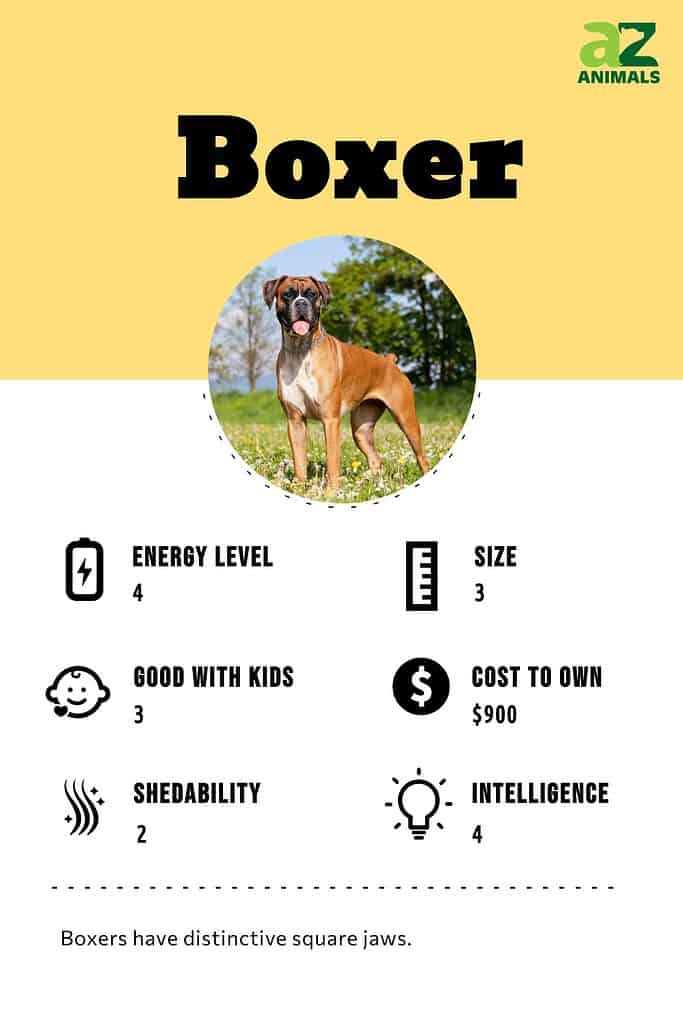
3 Pros and Cons of Owning a Boxer
| Pros! | Cons! |
|---|---|
| Playful: Boxers love to play. They would make a great companion pets for an older child. | Not ideal for families with small children: Boxers can get pretty excited easily and may jump around playfully. This could cause an accidental injury to a smaller child. |
| Intelligent: Boxers are very intelligent dogs. This makes them relatively easy to train compared to some other breeds. | Not great with dogs of the same sex: Boxers don’t always get along well with other dogs of the same sex. |
| Easy to Groom: Boxers don’t shed very much, and their short hair is easy to maintain by brushing it just a few times each week. | High activity needs: Boxers need plenty of opportunities for exercise. This is not a good breed to get if you won’t be able to meet these needs. |
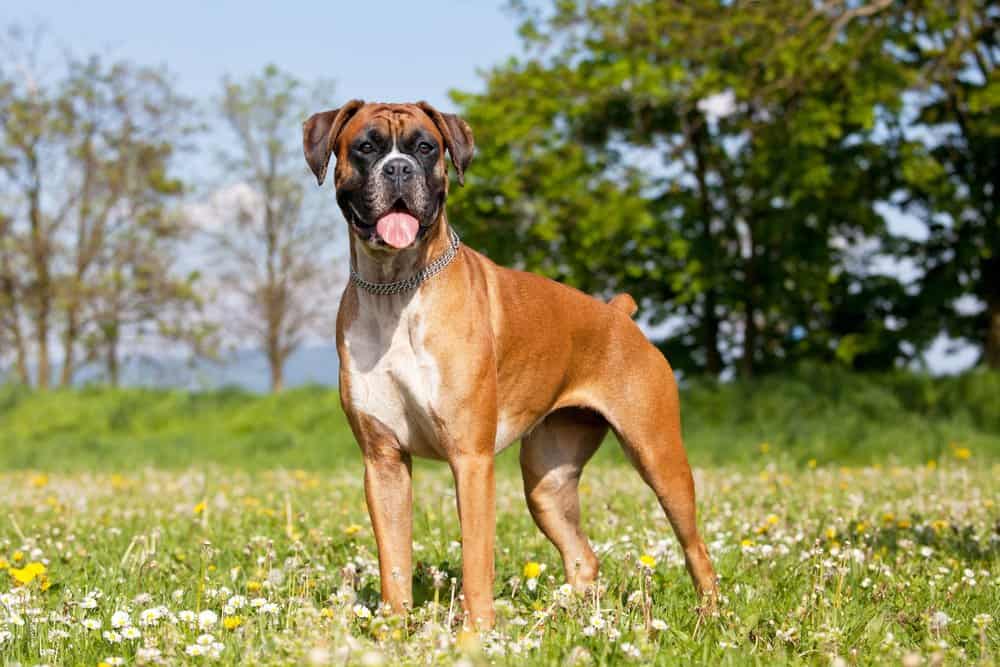
©Lenkadan/Shutterstock.com
History and Origins
The Boxer’s history can be traced back to the war dogs of the Assyrian empire 2,500 years ago. However, the modern version of the Boxer originated in Germany in the late 19th and early 20th centuries. German dog fanciers selectively bred down a heavier German breed, known as the Bullenbeisser (“bull biter”), to create the Boxer we know today.
Health and Entertainment for your Boxer Dog
See all of our expert product reviews.
During the medieval period, German noblemen used the Bullenbeisser to help them hunt large animals like bears, bison, and wild boar on their estates. However, with the changing political climate in Germany during the early 1800s, these estates were broken up, and the hunts stopped. By 1865, the Bullenbeisser was no longer needed.
Through careful breeding with a smaller mastiff-type breed from England, the Boxer dog was brought back to life in the late 1800s. This new version of the dog was more refined and sleek than its predecessor. The name “Boxer” comes from its habit of playfully punching with its front paws, like a boxer in a ring.
Throughout the years, Boxers have been employed in a variety of roles, including that of a police dog, athlete, cattle herder, war soldier (in both WWI and WWII), protector, guard dog, and guide dog for the visually impaired. The American Kennel Club recorded its first Boxer in 1904, although their popularity in the USA really began to take off in the 1950s following the success of a Westminster-winning Boxer named Bang Away, who became a national celebrity. Since then, Boxers have regularly been listed in the top 10 most beloved breeds in America.

Boxers are in the top 10 most popular dogs in America.
©Lenkadan/Shutterstock.com
Size and Weight
Boxers are medium- to large-sized breeds. Males are larger than females and typically weigh between 65 and 80 pounds, and are 23 to 25 inches tall. Females weigh between 50 and 65 pounds and are 21.5 to 23.5 inches tall. At two months of age, a Boxer puppy will weigh somewhere around 20 pounds. By the time a puppy is six months old, they generally weigh between 38 and 48 pounds. Boxers won’t be fully grown until they are at least 18 months, but some dogs may not finish growing until they are 24 months old. Learn more about how long boxers live.
| Male | Female | |
|---|---|---|
| Height | 23 inches to 25 inches | 21.5 inches to 23.5 inches |
| Weight | 65 pounds to 80 pounds | 50 pounds to 65 pounds |
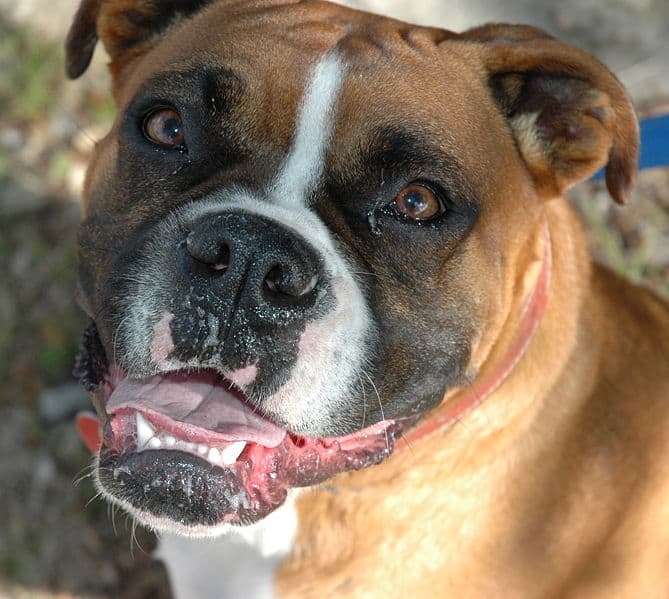
Boxers typically weigh between 50-80 pounds.
©Vicki Mitchell from Austin, US, CC BY 2.0, via Wikimedia Commons – Original / License
Common Health Issues
If you plan on bringing a Boxer home, there are a few common health concerns you should be aware of. One problem to be aware of is degenerative myelopathy. This is a condition that causes problems with a dog’s nervous system and spinal cord. Unfortunately, there is no treatment for this condition, and it will eventually lead to either full or partial paralysis of a Boxer’s lower limbs. If you notice that your dog is having difficulty walking or other symptoms, be sure to schedule an appointment with their vet right away.
Cardiomyopathy is another condition that Boxers may suffer from. Boxers are more at risk for this disorder than other dog breeds because of their genes. Boxers with Cardiomyopathy will have an irregular heartbeat and may faint. Their hearts are not able to effectively pump blood to all the different parts of their body. You may begin to notice symptoms of this disease when your dog is about two years old.
As large dogs, Boxers may also suffer from bloat. Bloat is a gastric disorder that causes the dog’s gastrointestinal system to swell. This prevents them from being able to digest their food and can be very serious if not treated immediately. Bloat often occurs after a dog eats a large meal and then is very active, so you should feed your dog smaller meals and hold off on exercising right after they have eaten.
To review, here are some of the common health problems that Boxers face:
- Degenerative myelopathy
- Cardiomyopathy
- Bloat

Boxers are prone to Degenerative myelopathy.
©Annet Oldenkamp/Shutterstock.com
Temperament
Boxers have a very fun-loving temperament. They are intelligent dogs who exhibit both playful and gentle traits. These characteristics make the Boxer a great family dog, especially for families with older children.
Boxers are very active and do require a good amount of exercise, but when their activity needs are met, they aren’t very likely to engage in destructive behaviors or get into too much trouble. Boxers also exhibit protective traits and try to watch out for the members of their families.
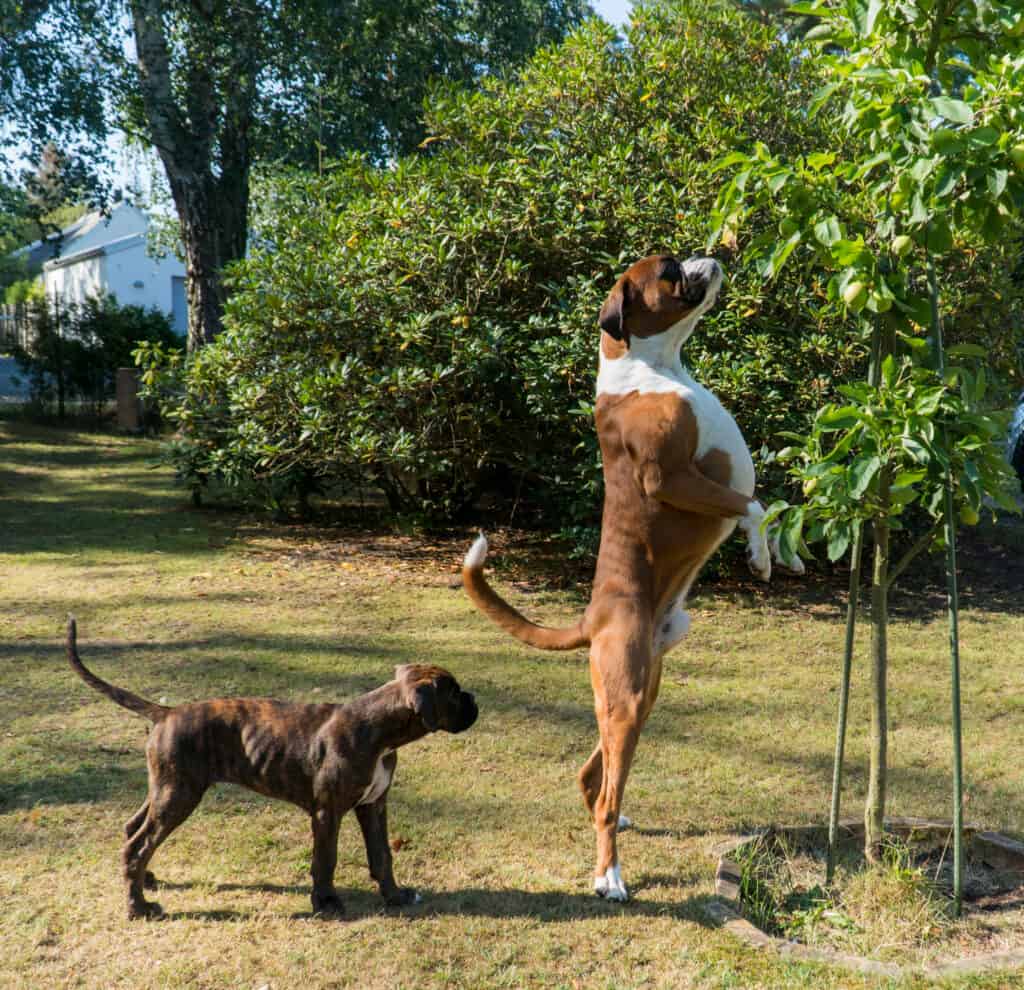
Boxers are fun-loving dogs who love to play silly and goofy games.
©Peter Roslund/Shutterstock.com
How to Take Care of a Boxer
Boxers are a very unique dog breed and, as such, will require a unique care plan. You’ll want to keep the temperament, nutritional needs, common health concerns, and other factors in mind when you plan for how you’ll care for your new Boxer.
The Best Dog Food
When selecting food for your Boxer, it is important to choose a high-quality option that will meet their nutritional needs. Since Boxers are prone to cardiomyopathy, owners may wish to steer clear of dog food containing legumes. Because a link has been found between heart failure in dogs that eat legumes in their food. Talk to your vet if you have questions about this issue and the reason many dog owners are opting for legume-free dog food.
You will want to be sure to portion out their food and give them the correct amount each day. Boxers should not be left to eat freely since they will overeat. Because of this, you will also want to break up their food each day into two or three servings. The right amount of food for your Boxer will vary based on his weight, age, activity level, and health concerns. You can always consult your veterinarian if you’re not sure how much they should be eating.
Your Boxer puppy will need to eat frequent, smaller meals throughout the day. This will prevent him from overeating or suffering from bloat. Young puppies should be given a mix of puppy food and water at least four times a day. As they get older, you should reduce the amount of water in the mixture so that eventually, they are eating straight puppy food (by the time they are about 7 weeks old). At eight weeks, Boxer puppies should be completely weaned from their mother and should eat about two cups of food each day. Since Boxer puppies are so active and are growing so quickly, they may eat up to twice as much as an adult boxer will.
At A-Z Animals, we think the perfect dog food for Boxers is Whole Earth Farms Adult Recipe Dry Dog Food due to their unique nutritional requirements. Read more about the other food we recommend for Boxers here.
This food does not contain legumes like peas, lentils, or chickpeas that may pose a threat to Boxers’ heart health. Instead, there’s plenty of protein from chicken and healthy grains to keep that big, lovable heart in good shape. Additionally, thiamine (vitamin B1), manganese, potassium, and copper work to protect Boxers’ nervous systems which can be affected by degenerative myelopathy.
Check out Whole Earth Farms Adult Recipe Dry Dog Food for Boxers for yourself and decide.
- Grain-inclusive
- Designed for adult dogs
- Contains no fake flavors, chemical preservatives, or artificial colors
- Budget-friendly
Maintenance and Grooming
Boxers are much easier to maintain and groom than many other dog breeds. They have a short coat that doesn’t shed too much. You should try to brush your dog using a hound glove or curry brush a few times a week to keep him looking good.
It will also be important to brush his teeth regularly to keep tartar from building up. Brushing once a day is ideal. You will also want to trim your Boxer’s nails about once a month to keep them from getting too long and making it uncomfortable for him to walk.
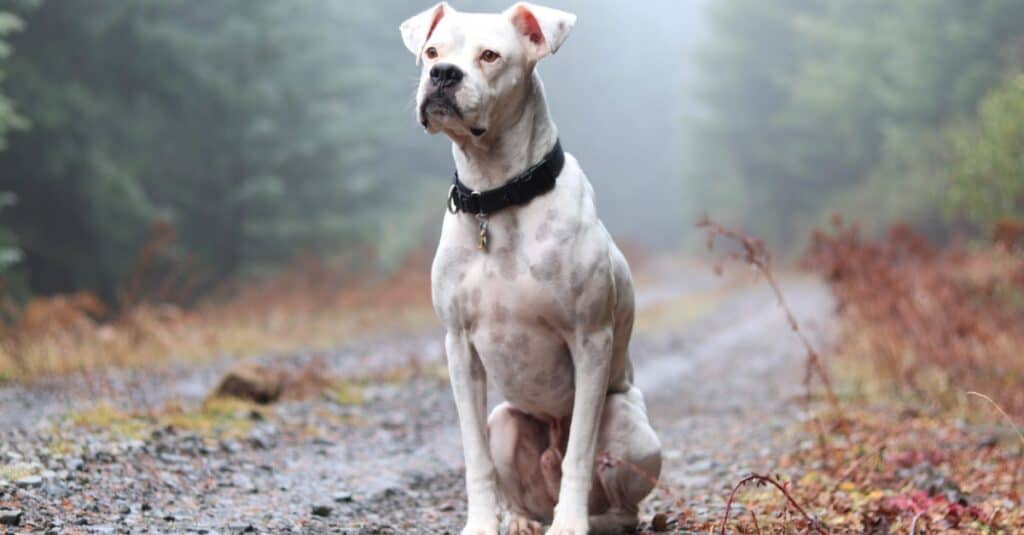
Boxers don’t have high-maintenance grooming needs.
©iStock.com/Amanda Woldt Photography
Training
Since Boxers are such an energetic breed, it will be important to begin training them from a young age. Look for opportunities to socialize your new dog and sign them up for puppy obedience training classes shortly after bringing him home. In general, Boxers can be relatively easy to train. They are very intelligent and can do well with herding, agility, and other canine sports.
However, Boxers may become bored with repetition. They are also not very accepting of other dogs of the same sex. These two characteristics could make it a little more challenging to train your dog.
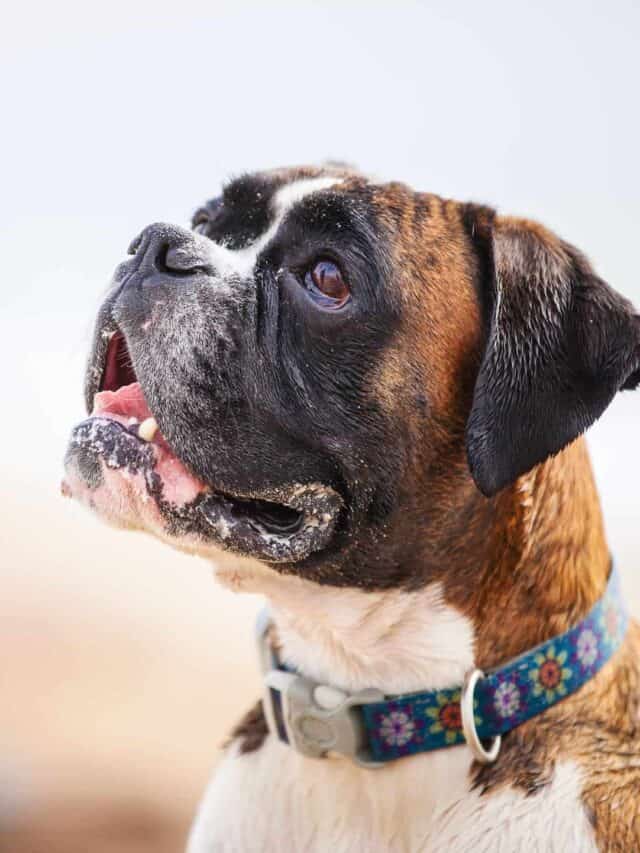
Boxers get bored with repetition, so be creative in training them.
©Photobac/Shutterstock.com
Exercise
It will be important to make sure that your Boxer gets plenty of exercise every day. They like to run and jump and may try to chase small animals, so it will be important to keep your Boxer on a leash if you go for a walk. In addition to taking your Boxer for walks, letting him run around in a fenced-in yard is another good way to give him the exercise he needs.
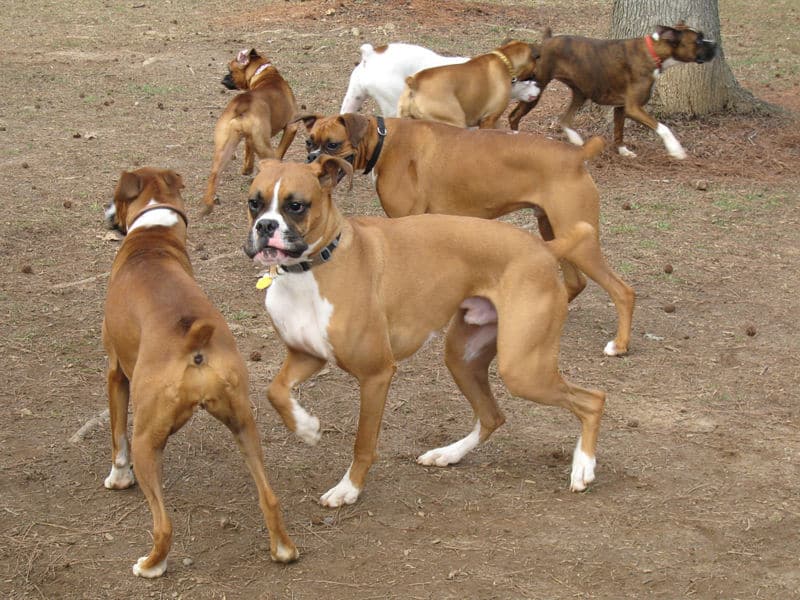
Boxers love to exercise by playing with other dogs.
©Flickr user boxercab, CC BY 2.0, via Wikimedia Commons – Original / License
Puppies
If you are going to be bringing home a Boxer puppy, be sure to puppy-proof your home before doing so. This will prevent an accidental injury for your new pup and can help make sure that something that is special to you doesn’t get destroyed. If your Boxer puppy hasn’t been potty-trained, you’ll want to get started with that right away. Be sure to set up a consistent schedule for your dog and look for signs that they are about to go so you can take them outside.
Boxer puppies will need to eat more frequently than adult Boxers, so be sure to plan for this and make sure you will be able to accommodate this schedule. Since they’ll be eating more frequently, you’ll want to be sure to get your Boxer out to use the bathroom more frequently as well.
Some other important things to keep in mind when caring for a Boxer puppy include getting them to the veterinarian for a check-up and vaccinations once you bring them home, making sure you have purchased all the necessary supplies and food you’ll need for your new dog, and finding plenty of time to play with them and meet their activity needs.

Puppy-proof your home before bringing home a boxer dog.
©cynoclub/Shutterstock.com
With Children
Boxers are very patient and loving dogs. They can make a great addition to a family with young children. However, because they are so energetic and like to leap, they may inadvertently injure a small child (or an older adult), so they are best suited for homes where the children are a little older. Regardless of the age of the child, it is always a good idea to supervise children around Boxers and other dogs to prevent any accidental injuries.
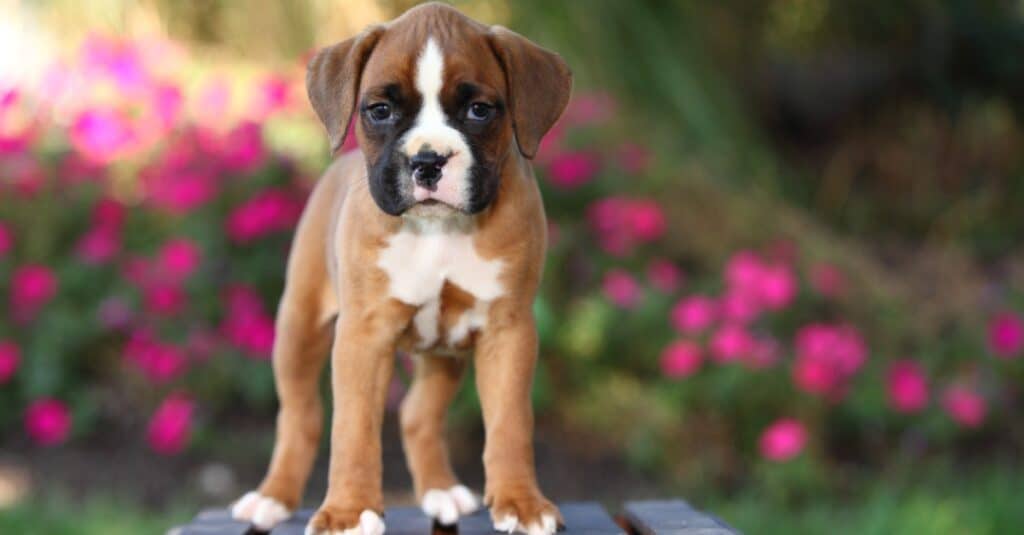
Boxers are patient and loyal to children and make great family pets.
©iStock.com/JLSnader
Dogs similar to Boxer
Bulldogs, Dogo Argentinos, and American Staffordshire Terriers are three breeds that are similar to the Boxer.
- Bulldog: Bulldogs and boxers are both medium- to large-breed dogs. Boxers are typically a few pounds heavier, with an average weight of 65 pounds for males. The average weight of a male Bulldog is only 54 pounds. Boxers and Bulldogs often have similar coloring. They can both be white, brindle, or fawn-colored. A key difference between these breeds is that Boxers are much more playful than Bulldogs.
- Dogo Argentino: The Dogo Argentino is a larger dog than the Boxer. They have an average weight of 93.5 pounds, while boxers only have an average weight of 65 pounds. Both breeds have short coats that are easy to groom. They both can make a good watchdog as well.
- American Staffordshire Terrier: American Staffordshire Terriers and Boxers are both relatively intelligent dogs who enjoy playing. American Staffordshire Terriers weigh about the same amount as a Boxer, but they are a few inches short. The average height of a male boxer is 23.5 inches, while a male Staffordshire Terrier only has an average height of 18 inches.

Treat children to be gentle with new puppies as they grow.
©iStock.com/:OLGA RYAZANTSEVA
Famous Boxers
As a very popular dog breed, there are plenty of boxers who have famous owners. Here are a few:
- Buckley and Brennan are Justin Timberlake’s Boxers
- Rocky used to be Kim Kardashian’s Boxer before she broke up with Reggie Bush.
- Harvey, Baby, and George were Humphrey Bogart and Lauren Bacall’s Boxers.
- Roxy and Bear are Jennifer Lopez’s Boxers.
Popular Names
Here are a few names you could consider for your pet Boxer.
- Bella
- Roxy
- Lucy
- Daisy
- Sadie
- Tyson
- Charlie
- Harley
- Duke
- Max
Boxer Dog FAQs (Frequently Asked Questions)
How much does Boxer cost to own?
The average cost of buying a Boxer puppy from a breeder is just under $900, but they could cost anywhere from $500 to $1,500 a year. If you adopt a Boxer from a rescue organization or a shelter, it will likely cost a couple of hundred dollars for the paperwork and vaccinations.
In addition to the cost of purchasing or adopting your new Boxer, you will also want to plan for the additional expenses of owning the dog. Your first year as a dog owner could cost $2,000 or more when you factor in medical expenses, food, toys, supplies, and everything else your dog will need. You should budget to spend around $1,000 to $1,500 for every other year you own your dog, but this amount may vary.
How long does Boxer live?
The average life expectancy for a boxer is 10 to 12 years.
What does a Boxer dog look like?
Boxers are a large-sized dog breed. They were bred in Germany from the Old English Bulldog and the now extinct Bullenbeisser. Boxers are square-jawed and well-built. A Boxer’s coat is smooth and their hair is short. They may be brindled, white, or fawn in color. Some boxers also have white markings. The area around their mouth is typically black.
Are Boxers good family dogs?
Yes, Boxers are a good family dog. They are loving, gentle, and enjoy playing. Because of their playful demeanor and larger size, though, they may not be the best dog for a family that still has small children. The Boxer could accidentally injure the child jumping up and wanting to play.
Are Boxer dogs dangerous?
No, Boxers are not a dangerous dog breed. While they are very active and playful, they are also very gentle and loving. They look for a lot of attention from the people in their family and can be stubborn at times, but they are not inherently dangerous.
A Boxer may look a bit intimidating due to their square-jawed appearance and large size, but they are not known to be aggressive. It is important to note that a Boxer may get a bit carried away when they are playing a game, so it is best not to play anything aggressive with your Boxer.
Are Boxers easy to train?
Yes, Boxers are relatively easy to train. They are very intelligent, which can aid in the training process. However, Boxers can become bored with too much repetition, so you should keep this in mind when training your dog. This breed tends to do best with positive reinforcement, so look for training options that are more positive.
What are Boxer dogs known for?
Boxers are known for their very distinct appearance. They have a black square-jawed face and may be brindled, fawn, or white in color.
Boxers are also often used as a service dog or a police dog. The American military has even used this breed as a messenger dog, guard dog, attack dog, or pack carrier at different times in history.
Are Boxer Dogs herbivores, carnivores, or omnivores?
Boxer Dogs are Omnivores, meaning they eat both plants and other animals.
What Kingdom do Boxer Dogs belong to?
Boxer Dogs belong to the Kingdom Animalia.
What class do Boxer Dogs belong to?
Boxer Dogs belong to the class Mammalia.
What phylum to Boxer Dogs belong to?
Boxer Dogs belong to the phylum Chordata.
What family do Boxer Dogs belong to?
Boxer Dogs belong to the family Canidae.
What order do Boxer Dogs belong to?
Boxer Dogs belong to the order Carnivora.
What genus do Boxer Dogs belong to?
Boxer Dogs belong to the genus Canis.
What type of covering do Boxer Dogs have?
Boxer Dogs are covered in Hair.
How many babies do Boxer Dogs have?
The average number of babies a Boxer Dog has is 8.
What is an interesting fact about Boxer Dogs?
Boxer Dogs are bright, energetic, and playful!
What is the scientific name for the Boxer Dog?
The scientific name for the Boxer Dog is Canis lupus.
Thank you for reading! Have some feedback for us? Contact the AZ Animals editorial team.
Sources
- David Burnie, Dorling Kindersley (2011) Animal, The Definitive Visual Guide To The World's Wildlife / Accessed November 10, 2008
- Tom Jackson, Lorenz Books (2007) The World Encyclopedia Of Animals / Accessed November 10, 2008
- David Burnie, Kingfisher (2011) The Kingfisher Animal Encyclopedia / Accessed November 10, 2008
- David Burnie, Dorling Kindersley (2008) Illustrated Encyclopedia Of Animals / Accessed November 10, 2008
- Dorling Kindersley (2006) Dorling Kindersley Encyclopedia Of Animals / Accessed November 10, 2008
- American Kennel Club / Accessed November 15, 2020
- Wikipedia / Accessed November 15, 2020
- Countryside Veterinary Clinic / Accessed November 15, 2020
- Trudog / Accessed November 15, 2020



















